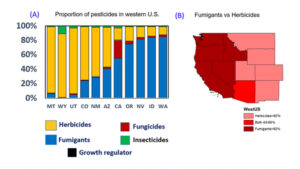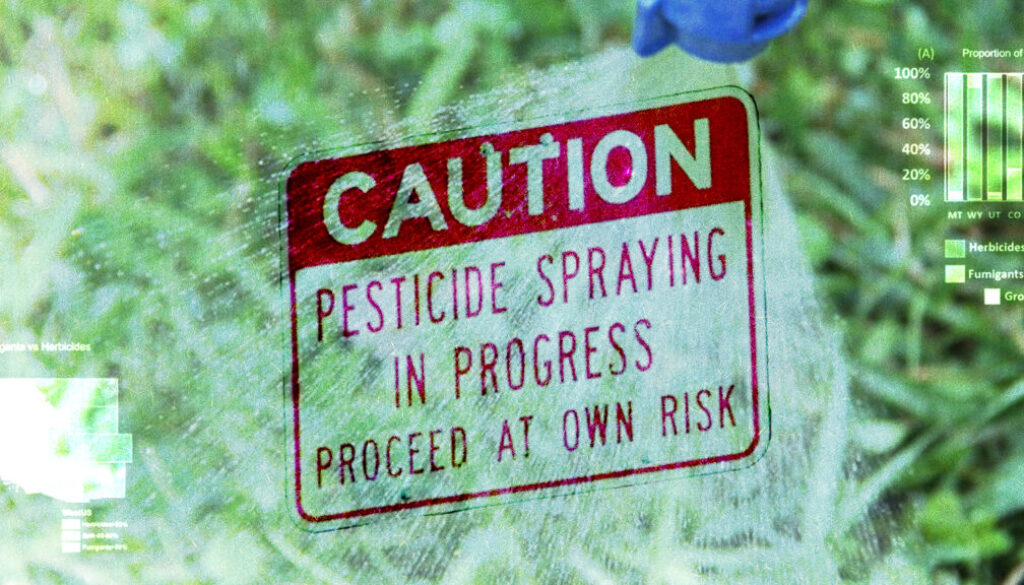New evidence of pesticide links to cancer
By Pam Strayer
Building on years of research that shows links between agricultural chemicals and cancer, researchers say they have found fresh evidence tying certain pesticides to cancers in children and adults in 11 western U.S. states.
Analyzing federal pesticide data and state health registries, the research team reported a close association between the use of pesticides called fumigants and the development of cancers in people living in the states analyzed.
The study, published last month in the journal GeoHealth, is the first to analyze the geospatial distribution of cancer incidence with pesticide use in the Western United States. The authors are three researchers from the Idaho Water Resources Research Institute at the University of Idaho and three researchers from Northern Arizona University.
Fumigants are pesticides typically applied to soil to control pests that can hinder plant growth and crop production. The fumigants can be used to control insects, weeds, fungi, and harmful bacteria. The U.S. Environmental Protection Agency (EPA) warns that when applied the chemicals form a gas and can move through the air to impact people hours or days after the chemical is applied.
In a press release issued by the University of Idaho, the researchers said the incidence of cancer was more closely associated with fumigants used in western states that produce food such as vegetables and fruit, as opposed to states using pesticides in the production of grains such as corn and wheat.
“We saw a significant relationship,” Alan Kolok, professor at the University of Idaho’s College of Natural Resources, said in the university press release. “It tells us something that we need to explore further.”
The researchers said a cancer connection to the widely used fumigant metam sodium was noteworthy. The fumigant metam is most commonly used in farming carrots, vegetables, potatoes, berries, strawberries and tomatoes, according to California state data. The EPA has previously classified metam as a probable carcinogen.

The scientists used a source that they said had previously been untapped by ecotoxicology researchers– a database of county use statistics on 125 pesticides from the United States Geological Survey (USGS) Pesticide National Synthesis Project–coupled with the data from the Cancer Data Registry of Idaho for a related study and National Cancer Institute State Cancer Profiles for the broad analysis of states.
“The interesting thing here is that the USGS has a database, where you can access county by county information on the mass of pesticide per acre within the county per year,” said Kolok. “That is kilograms per acre per year for every county in the United States for over 500 different pesticides. It’s an enormous database.”
The states included in the analysis are Arizona, California, Colorado, Idaho, Montana, Nevada, New Mexico, Oregon, Utah, Washington, and Wyoming.
The researchers said in the study that their results lay the groundwork for “large-scale analyses of potential indicators of cancer incidence, such as pesticide exposure… to determine whether specific exposures may be leading to potential negative human health outcomes.”
The study “has facilitated the identification of priority areas in the U.S. West where increased public health attention may be beneficial, in addition to highlighting specific pesticides of interest. This method of analysis may be particularly useful in informing directed research that can address whether there is a causative, as well as correlative, linkage between environmental factors and adverse health outcomes,” the researchers said.
Previous U.S. epidemiological studies have relied upon more specific location data, with some using the detailed pesticide application statistics available only in California where pesticide use reporting is mandatory. The Idaho team’s unique finding was that coarser data sources, available for the whole country, revealed correlations.
“Looking state by state by state, again, we find that fumigants and metam are correlated with cancers–either pediatric cancer or total cancers. Then we did a third analysis across 414 counties and when we did that, again, the same fumigants, the same metam kind of lit up the correlational analysis. So we were finding the same thing in these analyses over and over and over again, which is really, really surprising. We did not expect that,” Kolok said.
The results should be evaluated with caution, he added.
“The study doesn’t necessarily mean that fumigants cause cancer, it doesn’t necessarily mean that metam causes cancer,” he said. “But there’s a correlation here, there’s a relationship. And we would argue that it would be prudent for us to evaluate that more closely.”
 EWG
EWG



July 8, 2022 @ 7:01 pm
July 29, 2021 Bayer to pull glyphosate from stores due to cancer lawsuits
Bayer announced it would take glyphosate off of store shelves by 2023 to avoid future costly lawsuits related to the chemicals potential to cause cancer.
https://www.courthousenews.com/bayer-to-pull-glyphosate-from-stores-due-to-cancer-lawsuits/